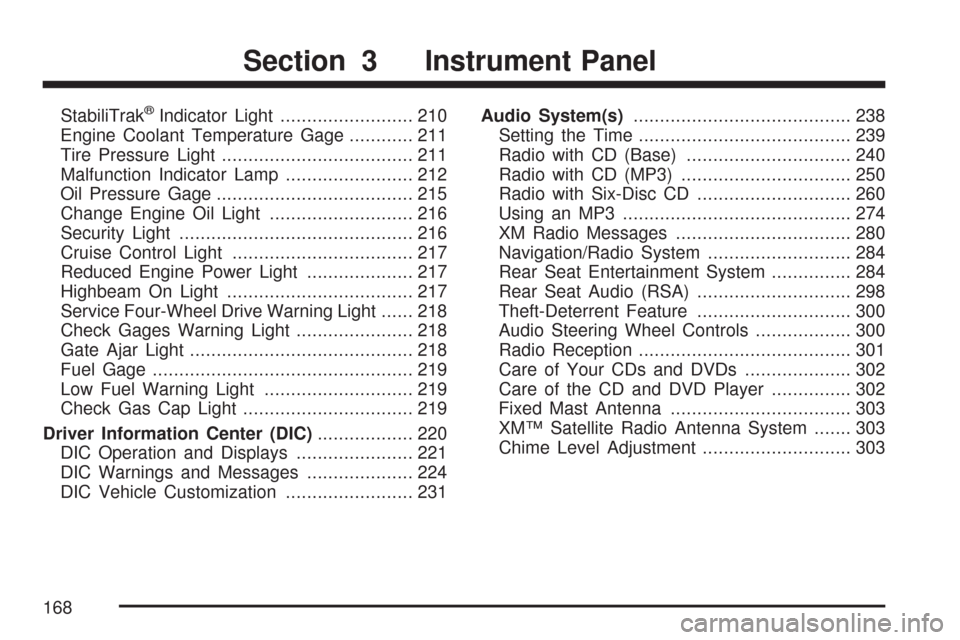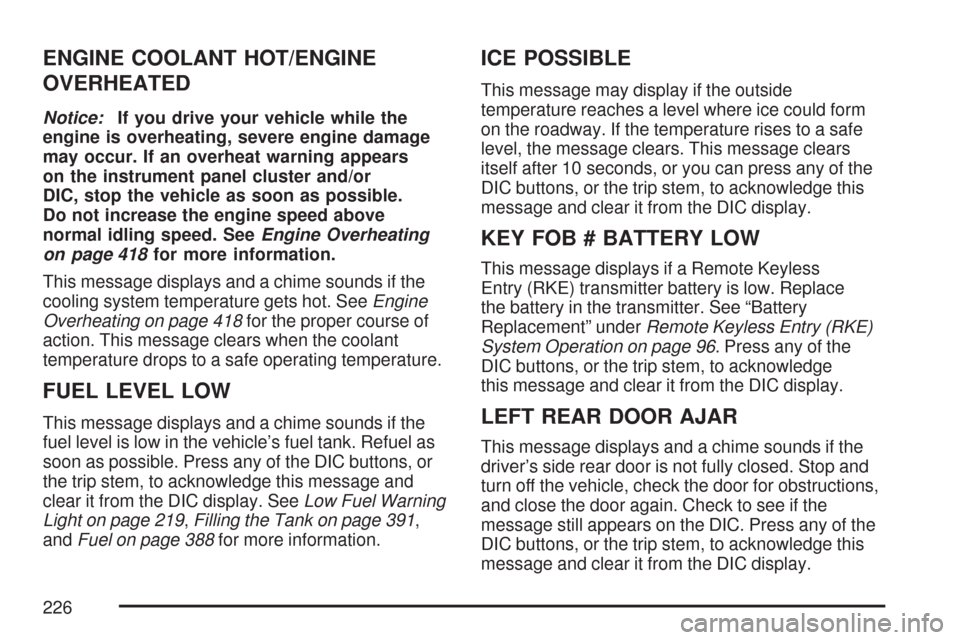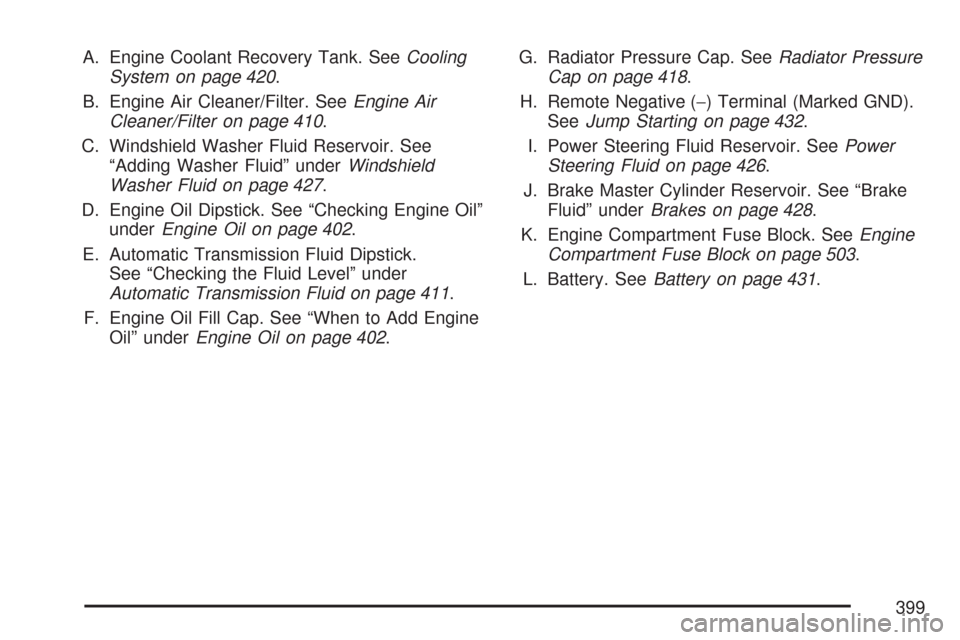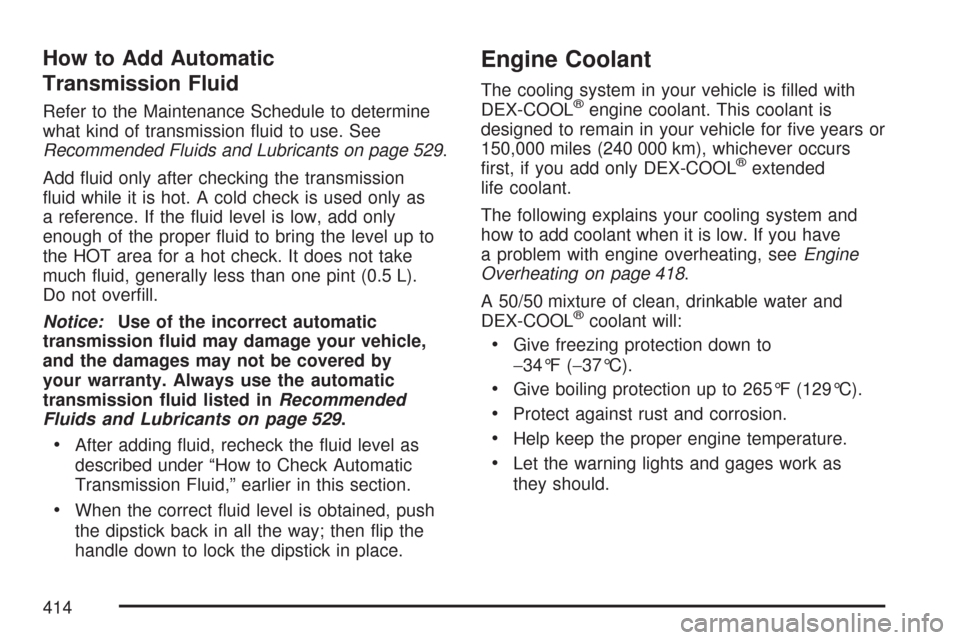2007 CHEVROLET TRAIL BLAZER coolant level
[x] Cancel search: coolant levelPage 168 of 574

StabiliTrak®Indicator Light......................... 210
Engine Coolant Temperature Gage............ 211
Tire Pressure Light.................................... 211
Malfunction Indicator Lamp........................ 212
Oil Pressure Gage..................................... 215
Change Engine Oil Light........................... 216
Security Light............................................ 216
Cruise Control Light.................................. 217
Reduced Engine Power Light.................... 217
Highbeam On Light................................... 217
Service Four-Wheel Drive Warning Light...... 218
Check Gages Warning Light...................... 218
Gate Ajar Light.......................................... 218
Fuel Gage................................................. 219
Low Fuel Warning Light............................ 219
Check Gas Cap Light................................ 219
Driver Information Center (DIC).................. 220
DIC Operation and Displays...................... 221
DIC Warnings and Messages.................... 224
DIC Vehicle Customization........................ 231Audio System(s)......................................... 238
Setting the Time........................................ 239
Radio with CD (Base)............................... 240
Radio with CD (MP3)................................ 250
Radio with Six-Disc CD............................. 260
Using an MP3........................................... 274
XM Radio Messages................................. 280
Navigation/Radio System........................... 284
Rear Seat Entertainment System............... 284
Rear Seat Audio (RSA)............................. 298
Theft-Deterrent Feature............................. 300
Audio Steering Wheel Controls.................. 300
Radio Reception........................................ 301
Care of Your CDs and DVDs.................... 302
Care of the CD and DVD Player............... 302
Fixed Mast Antenna.................................. 303
XM™ Satellite Radio Antenna System....... 303
Chime Level Adjustment............................ 303
Section 3 Instrument Panel
168
Page 188 of 574

To change the current mode, select one of the
following:
H(Vent):This mode directs air to the instrument
panel outlets.
)(Bi-Level):This mode directs about half of
the air to the instrument panel outlets; then directs
most of the remaining air to the �oor outlets. A little
air is directed toward the windshield and the side
window outlets. Cooler air is directed to the upper
vents and warmer air to the �oor outlets.
6(Floor):This mode directs most of the air to the
�oor outlets with a little air directed to the windshield
and the side window outlets. The recirculation
button cannot be selected while in �oor mode.
@(Recirculation):Recirculation mode is used
to recirculate the air inside of your vehicle. When
this button is pressed, an indicator light in the
button will come on to let you know that it is active.
Use this mode to help prevent outside odors and/or
dust from entering your vehicle or to help cool the
air inside of your vehicle more quickly. The air
conditioning compressor will also come on when
this mode is activated. While in recirculation mode,the windows may fog when the weather is cold and
damp. To clear the fog, select either the defog or
defrost mode and increase fan speed.
Defog and defrost modes are described later in this
section.
Driver’s Side Temperature Lever:The lever on
the left side of the climate control panel is
used to raise or lower the temperature on the
driver’s side of the vehicle. Slide the lever up or
down to adjust the temperature.
Passenger’s Side Temperature Lever:The lever
on the right side of the climate control panel is
used to raise or lower the temperature on the
passenger’s side of the vehicle. Slide the lever up
or down to adjust the temperature. This lever also
adjusts the temperature to the rear seat outlets.
When the temperature outside is 0°F (-18°C) or
lower, use the engine coolant heater, if the vehicle
has one, to provide warmer air, faster to your
vehicle.
#(Air Conditioning):Press this button to turn
the air-conditioning system on or off. When the
button is pressed, an indicator light will come on
and the system will begin to cool and dehumidify
188
Page 226 of 574

ENGINE COOLANT HOT/ENGINE
OVERHEATED
Notice:If you drive your vehicle while the
engine is overheating, severe engine damage
may occur. If an overheat warning appears
on the instrument panel cluster and/or
DIC, stop the vehicle as soon as possible.
Do not increase the engine speed above
normal idling speed. SeeEngine Overheating
on page 418for more information.
This message displays and a chime sounds if the
cooling system temperature gets hot. SeeEngine
Overheating on page 418for the proper course of
action. This message clears when the coolant
temperature drops to a safe operating temperature.
FUEL LEVEL LOW
This message displays and a chime sounds if the
fuel level is low in the vehicle’s fuel tank. Refuel as
soon as possible. Press any of the DIC buttons, or
the trip stem, to acknowledge this message and
clear it from the DIC display. SeeLow Fuel Warning
Light on page 219,Filling the Tank on page 391,
andFuel on page 388for more information.
ICE POSSIBLE
This message may display if the outside
temperature reaches a level where ice could form
on the roadway. If the temperature rises to a safe
level, the message clears. This message clears
itself after 10 seconds, or you can press any of the
DIC buttons, or the trip stem, to acknowledge this
message and clear it from the DIC display.
KEY FOB # BATTERY LOW
This message displays if a Remote Keyless
Entry (RKE) transmitter battery is low. Replace
the battery in the transmitter. See “Battery
Replacement” underRemote Keyless Entry (RKE)
System Operation on page 96. Press any of the
DIC buttons, or the trip stem, to acknowledge
this message and clear it from the DIC display.
LEFT REAR DOOR AJAR
This message displays and a chime sounds if the
driver’s side rear door is not fully closed. Stop and
turn off the vehicle, check the door for obstructions,
and close the door again. Check to see if the
message still appears on the DIC. Press any of the
DIC buttons, or the trip stem, to acknowledge this
message and clear it from the DIC display.
226
Page 378 of 574

Making Turns
Notice:Making very sharp turns while
trailering could cause the trailer to come in
contact with the vehicle. Your vehicle could be
damaged. Avoid making very sharp turns
while trailering.
When you’re turning with a trailer, make wider
turns than normal. Do this so your trailer
won’t strike soft shoulders, curbs, road signs,
trees or other objects. Avoid jerky or sudden
maneuvers. Signal well in advance.
Turn Signals When Towing a Trailer
The arrows on your instrument panel will
�ash whenever you signal a turn or lane change.
Properly hooked up, the trailer lamps will also
�ash, telling other drivers you’re about to
turn, change lanes or stop.
When towing a trailer, the arrows on your
instrument panel will �ash for turns even if the bulbs
on the trailer are burned out. Thus, you may think
drivers behind you are seeing your signal when
they are not. It’s important to check occasionally to
be sure the trailer bulbs are still working.
Driving On Grades
Reduce speed and shift to a lower gearbefore
you start down a long or steep downgrade. If you
don’t shift down, you might have to use your
brakes so much that they would get hot and no
longer work well.
You can tow in DRIVE (D). You may want to shift
the transmission to THIRD (3) or a lower gear,
under heavy loads or hilly conditions.
When towing at high altitude on steep uphill
grades, consider the following: Engine coolant will
boil at a lower temperature than at normal
altitudes. If you turn your engine off immediately
after towing at high altitude on steep uphill grades,
your vehicle may show signs similar to engine
overheating. To avoid this, let the engine run while
parked (preferably on level ground) with the
automatic transmission in PARK (P) for a few
minutes before turning the engine off. If you do get
the overheat warning, seeEngine Overheating
on page 418.
378
Page 397 of 574

A. Engine Air Cleaner/Filter. SeeEngine Air
Cleaner/Filter on page 410.
B. Engine Coolant Recovery Tank. SeeCooling
System on page 420.
C. Windshield Washer Fluid Reservoir. See
“Adding Washer Fluid” underWindshield
Washer Fluid on page 427.
D. Power Steering Fluid Reservoir. SeePower
Steering Fluid on page 426.
E. Automatic Transmission Fluid Dipstick (Out of
View). See “Checking the Fluid Level” under
Automatic Transmission Fluid on page 411.
F. Engine Oil Dipstick. See “Checking Engine Oil”
underEngine Oil on page 402.G. Radiator Pressure Cap. SeeRadiator Pressure
Cap on page 418.
H. Engine Oil Fill Cap. See “When to Add Engine
Oil” underEngine Oil on page 402.
I. Remote Negative (−) Terminal (Marked GND).
SeeJump Starting on page 432.
J. Brake Master Cylinder Reservoir. See “Brake
Fluid” underBrakes on page 428.
K. Battery. SeeBattery on page 431.
L. Engine Compartment Fuse Block. SeeEngine
Compartment Fuse Block on page 503.
397
Page 399 of 574

A. Engine Coolant Recovery Tank. SeeCooling
System on page 420.
B. Engine Air Cleaner/Filter. SeeEngine Air
Cleaner/Filter on page 410.
C. Windshield Washer Fluid Reservoir. See
“Adding Washer Fluid” underWindshield
Washer Fluid on page 427.
D. Engine Oil Dipstick. See “Checking Engine Oil”
underEngine Oil on page 402.
E. Automatic Transmission Fluid Dipstick.
See “Checking the Fluid Level” under
Automatic Transmission Fluid on page 411.
F. Engine Oil Fill Cap. See “When to Add Engine
Oil” underEngine Oil on page 402.G. Radiator Pressure Cap. SeeRadiator Pressure
Cap on page 418.
H. Remote Negative (−) Terminal (Marked GND).
SeeJump Starting on page 432.
I. Power Steering Fluid Reservoir. SeePower
Steering Fluid on page 426.
J. Brake Master Cylinder Reservoir. See “Brake
Fluid” underBrakes on page 428.
K. Engine Compartment Fuse Block. SeeEngine
Compartment Fuse Block on page 503.
L. Battery. SeeBattery on page 431.
399
Page 401 of 574

A. Engine Coolant Recovery Tank. SeeCooling
System on page 420.
B. Engine Air Cleaner/Filter. SeeEngine Air
Cleaner/Filter on page 410.
C. Windshield Washer Fluid Reservoir. See
“Adding Washer Fluid” underWindshield
Washer Fluid on page 427.
D. Engine Oil Dipstick (Out of View). See
“Checking Engine Oil” underEngine Oil on
page 402.
E. Automatic Transmission Fluid Dipstick.
See “Checking the Fluid Level” under
Automatic Transmission Fluid on page 411.
F. Engine Oil Fill Cap (Under Engine Cover).
See “When to Add Engine Oil” underEngine
Oil on page 402.G. Radiator Pressure Cap. SeeRadiator Pressure
Cap on page 418.
H. Remote Negative (−) Terminal (Marked GND).
SeeJump Starting on page 432.
I. Power Steering Fluid Reservoir. SeePower
Steering Fluid on page 426.
J. Brake Master Cylinder Reservoir. See “Brake
Fluid” underBrakes on page 428.
K. Engine Compartment Fuse Block. SeeEngine
Compartment Fuse Block on page 503.
L. Battery. SeeBattery on page 431.
401
Page 414 of 574

How to Add Automatic
Transmission Fluid
Refer to the Maintenance Schedule to determine
what kind of transmission �uid to use. See
Recommended Fluids and Lubricants on page 529.
Add �uid only after checking the transmission
�uid while it is hot. A cold check is used only as
a reference. If the �uid level is low, add only
enough of the proper �uid to bring the level up to
the HOT area for a hot check. It does not take
much �uid, generally less than one pint (0.5 L).
Do not over�ll.
Notice:Use of the incorrect automatic
transmission �uid may damage your vehicle,
and the damages may not be covered by
your warranty. Always use the automatic
transmission �uid listed inRecommended
Fluids and Lubricants on page 529.
After adding �uid, recheck the �uid level as
described under “How to Check Automatic
Transmission Fluid,” earlier in this section.
When the correct �uid level is obtained, push
the dipstick back in all the way; then �ip the
handle down to lock the dipstick in place.
Engine Coolant
The cooling system in your vehicle is �lled with
DEX-COOL®engine coolant. This coolant is
designed to remain in your vehicle for �ve years or
150,000 miles (240 000 km), whichever occurs
�rst, if you add only DEX-COOL
®extended
life coolant.
The following explains your cooling system and
how to add coolant when it is low. If you have
a problem with engine overheating, seeEngine
Overheating on page 418.
A 50/50 mixture of clean, drinkable water and
DEX-COOL
®coolant will:
Give freezing protection down to
−34°F (−37°C).
Give boiling protection up to 265°F (129°C).
Protect against rust and corrosion.
Help keep the proper engine temperature.
Let the warning lights and gages work as
they should.
414